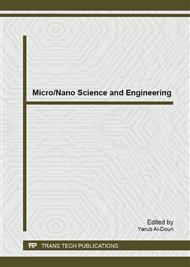p.416
p.420
p.428
p.433
p.436
p.442
p.450
p.455
p.460
A44_ Effect of Nano-Sized ZnO on Electrical & Structural Properties of High Temperature Tl2-x HgxBa2Ca2Cu3O10-δ Superconductors
Abstract:
The electrical resistivity of high temperature superconductivity Tl2-xHgxBa2Ca2Cu3O10- δ has been measured in the temperature range from 90K to 330K. These results showed that the critical temperature of the zero resistivity increases from 127K to 138K ,when the Hg concentration increased from 0 to 0.5. The structure of the Tl2-xHgxBa2Ca2Cu3O10-δ compound has also investigated by using X- ray diffraction technique. This compound has tetragonal type structure with a=b=5.36A & c=36.09A and the magnitude of c-axis increases to 37.8A when x increased to 0.5. Nano ZnO was add to the sample with concentration (0-1) wt% of the ( Tl2- xHgxBa2Ca2Cu3O10- δ) samples mass. The effect of the nano ZnO concentration substitution on the samples investigated on structure and critical temperature of the best sample properties (when x=0.5)and showed that the structure remains tetragonal and c-axis increased to 39.2A when nano sized concentration 0.8% and Tc increase to 146K but c-axis decreased to 38.4A and Tc decreased to 143K when the ZnO concentration 1%.
Info:
Periodical:
Pages:
436-441
Citation:
Online since:
April 2014
Authors:
Price:
Сopyright:
© 2014 Trans Tech Publications Ltd. All Rights Reserved
Share:
Citation:



